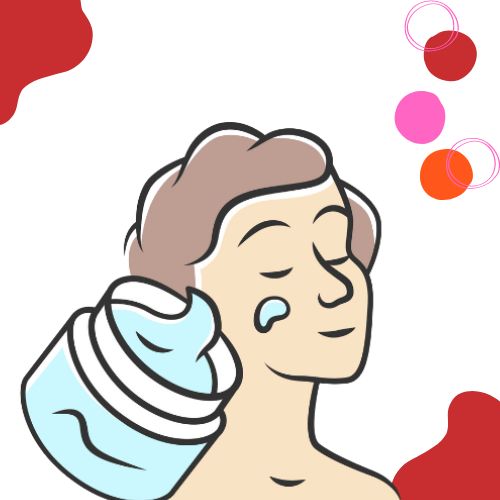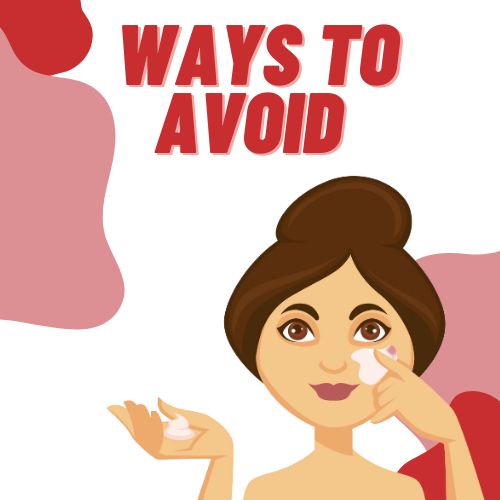Many of you may not know that over-moisturizing could cause acne. When you use too much lotion or cream on your face, your skin absorbs just what it needs to keep moisturized. The rest of the residue then lingers atop your face, forming a thin layer of oil and bacteria that causes your pores to clog.
But you can avoid or treat an over-moisturised face. In this article, I will share with you the signs of an over-moisturised face and how to treat it.
Stay with me.
Table of Contents
Signs to Consider if you have an Over-Moisturised Face

1. Your pores are clogged
When you over-moisturise your face, the first visible sign is clogged pores. Clog pores explain a phenomenon where you have blackheads or whiteheads on your face increasingly and consistently.
You may overlook it at first, but with time, you will notice that your face is plagued with blackheads.
Likewise, moisturising your face to the extreme can cause inflammation or breakouts on the skin. Your skin absorbs what it needs, and the extra product just sits on top of your face. With nowhere to go, this extra moisturizer will eventually fill up the pores on your skin.
This greasy layer attracts dirt and bacteria, which then gets accumulated in the pores and cause acne.
2. Your sebum production increases
Similarly, if your skin is already oily, over-moisturizing can trigger the body to produce more oil, which in turn may cause acne and more breakouts.
When used sparingly, moisturiser will reduce oil production, but when applied excessively, it may trigger it. This could lead to excessive sebum production.
3. Your skin has become dry
Whenever you over-moisturize your face, the amount of oil your skin produces begins to lower. This eventually causes the skin to become dry. Dry skin, in turn, leads to the depletion of vitamin E. Consequently, your skin becomes dull and hazy.
You must choose the right moisturizer based on your skin type when this happens. Vitamin E and hyaluronic acid are effective moisturizers for dry skin. Your face will also be attracted to water by ingredients such as glycerin and urea.
You should also use a non-comedogenic moisturizer since your skin is naturally oily. As a result, it won’t cause your pores to clog.
4. You have small bumps all over your face
You should always use products that are specifically made for your face because the skin on your face is more sensitive. It is not a good idea to apply body lotion to your face.
If you’re seeing little knots of white bumps on your face, they’re not acne. Although milia are nothing to be alarmed about, you need to visit a dermatologist to find out what’s wrong. And they often come with redness, irritation, or rashes.
Don’t try to squeeze the milia. It will only get worse if you do. The most serious downside effect of using the wrong moisturiser is the growth of milia. Malia is small, hard white pimples on the skin that appear in random places. If you detect little bumps, you should discontinue using your moisturiser.
These indicators that you’re using the wrong moisturiser may encourage you to reassess your skincare routine, but always seek professional advice if you detect changes in your skin.
5. Your Skin Feels Tight
When we moisturise, we pull water from the air and keep it on our skin. This is what soothes itching and skin stiffness. Over-moisturising, on the other hand, removes that sensation, leaving you feeling tight.
This is the inverse of what a moisturiser is supposed to do. Tight skin is typically what occurs before your skin begins to dry out.
In reaction, if you see your skin tightening in a specific location, it’s probably a good idea to reduce the amount of moisturiser you’re using.
6. Your skin feels greasy.
Oily skin occurs when your glands create excessive sebum, resulting in a greasy surface, plugged pores, and acne.
Certain sunscreens might leave a greasy film on the skin’s surface, causing blemishes and skin irritations.
7. The make-up products don’t sit right on your face.
An over-moisturised face may not comply well with makeup. Hence, if your makeup is not sitting well on your face, it’s time to revisit your moisturiser and makeup products.
How to avoid moisturizing too much?

1. Exfoliate
Making sure your skin is free of dead skin cells is a good approach to utilising a moisturiser sparingly and efficiently. Dead skin makes it difficult for your skin to absorb moisture, so removing it is critical.
Exfoliate using a gentle product at least once or twice a week to eliminate dead skin cells on the skin’s surface.
2. Use a small amount.
It’s quite pleasant to squeeze an additional drop of moisturiser and massage it into your face. However, it can cause your skin to clog and lower the absorption rate of your moisturiser, resulting in less sebum production and dry skin.
The idea that applying a significant amount of moisturiser will provide a long-lasting impact is erroneous, even in cold weather conditions when dry skin is caused by the cold air.
Instead, apply a small amount of the best moisturiser for your skin type and massage it thoroughly. Too many cosmetics might overstimulate and suffocate your skin. A small amount of the correct product can go a long way toward good skin!
3. Consistency over quantity.
Instead of slathering it on all at once, reapplying your moisturiser regularly not only helps your skin control its sebum production but also protects the skin barrier.
4. Change Your Moisturiser.
Various skin types demand different treatments and ways of hydrating their skin.
Lack of skin moisture may be the primary cause of excessive sebum production in oily skin. Products containing humectant-based moisturising ingredients, such as hyaluronic acid, are the most effective at retaining skin hydrated.
An emollient-based moisturiser with components like squalene is ideal for dry, normal, or combination skin since the oils and fatty acids may cover the cracks in the skin and help it keep the skin barrier intact.
Using a thick, occlusive-based moisturiser helps to seal and hold moisture into the skin in cases of developed or severely parched dry skin, which typically occurs during menopause transition stages.
5. Remove some routines.
The issue is that we may underestimate the hydrating and moisturising properties of some products, resulting in over-moisturized skin.
Leaving out procedures like essence, eye cream, and sheet masks, which typically contain high moisturising and hydrating components, leads to either extremely dry or overly moisturised skin.
6. Apply moisturizer when the skin is still moist.
One of the simplest ways to avoid over-moisturising is to apply your moisturiser when your skin is still damp. This prevents you from feeling the need to apply extra moisture to your skin, which could hurt it.
7. Drink enough water.
Drinking adequate amounts of water throughout the day leads to less blockage of the skin glands and less inflammation.
Drink at least two litres of water every day and avoid soda, which does not hydrate you as well and can even cause skin problems.
8. Avoid heavy make-up
Wearing a lot of makeup can cause more breakouts and acne-prone skin. Full-coverage makeup stimulates oil production and clogs pores. Choose lighter textures and look for products with terms like “oil-control” or “mattifying.”
Try powder-finish cosmetics, such as Glossier’s Wowder, and see a skin specialist to help you clear your skin so you can use less makeup. While you’re at it, clean your brushes regularly.
Ingredients to avoid in moisturisers
Ingredients such as diethanolamine, monoethanolamine, and triethanolamine should be avoided in general. These three elements are colourless and transparent. They are commonly found in cleansers and soaps, but they do not mix well with your average moisturiser.
Mineral oil-based moisturisers should also be avoided. Mineral oil is a petroleum byproduct that leaves a plastic-like skin layer around your pores. This clogs them, and as a result, your pores will develop acne.
Frequently Asked Questions (FAQs)
How Often Should You Moisturise Your Skin?
You can moisturise every day. A moisturiser can be used twice a day, once in the morning and once at night as a part of your morning and night skincare routine, respectively.
How do you know if you are over-moisturizing?
Your skin is dry, you have clogged pores, you break out a lot, you have increased sebum production, and your skin feels tight.
What does over the moisturised face look like?
Your product should last you a few months, not a few weeks. Running through the product quickly indicates you might be using too much of it. Some signs you may be over-moisturizing are clogged pores, blackheads, bumpy skin, and excess oil.
What happens if you moisturize your face too much?
By over-moisturizing, you can cause the skin’s barrier function to weaken and risk clogging pores. This results in dry skin and body acne- the allover equivalent of combination skin.
How should skin feel after moisturizing?
It should allow you to layer makeup on top of it without causing it to pile up. Spinning off that, other docs say your moisturizer should also feel super silky and lightweight like it’s being absorbed easily into your gorgeous skin without you even feeling it.
How often should I moisturize my face?
Twice daily. Generally accepted advice about the use of moisturizers is to apply them twice daily—every morning and every night. It’s the most commonly accepted practice because it ensures that the moisture content of your skin remains constant throughout the entire 24-hour period.
Can over moisturizing cause wrinkles?
Aesthetic dermatologists have observed that habitual, daily moisturising over a prolonged period can age the skin. This induced ageing occurs because the same fibroblast cells that produce the skin’s moisturiser also produce collagen and elastin, which help maintain the skin’s elasticity.
Is it OK not to moisturize at night?
Many people can get by without using a facial moisturizer at night. If your skin is normal — it isn’t dry or sensitive, and you don’t have a medical condition — nighttime creams are superfluous. The most important thing you can do to maintain normal, healthy skin is to wear sunscreen and wash your face daily with a mild soap.
Now it’s your turn…
As established, the most obvious sign of excessive moisturizing is clogged pores. Over moisturising, your face or skin can cause acne and breakouts, which lead to blackheads and eventually dark spots.
Noticing the early signs and avoiding over-moisturising will go a long way to save you money, stress, and, of course, beautiful skin!
Related Articles:


